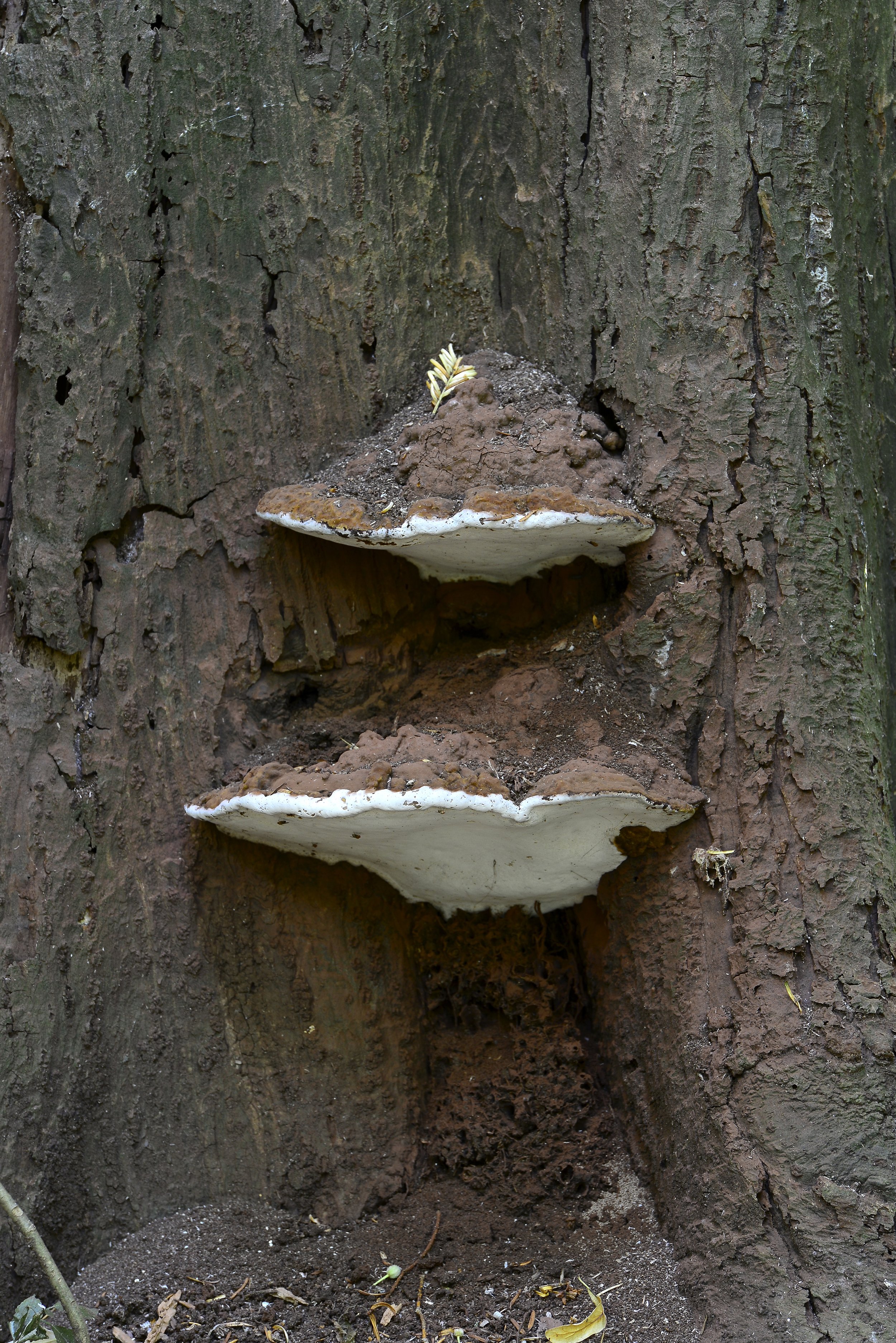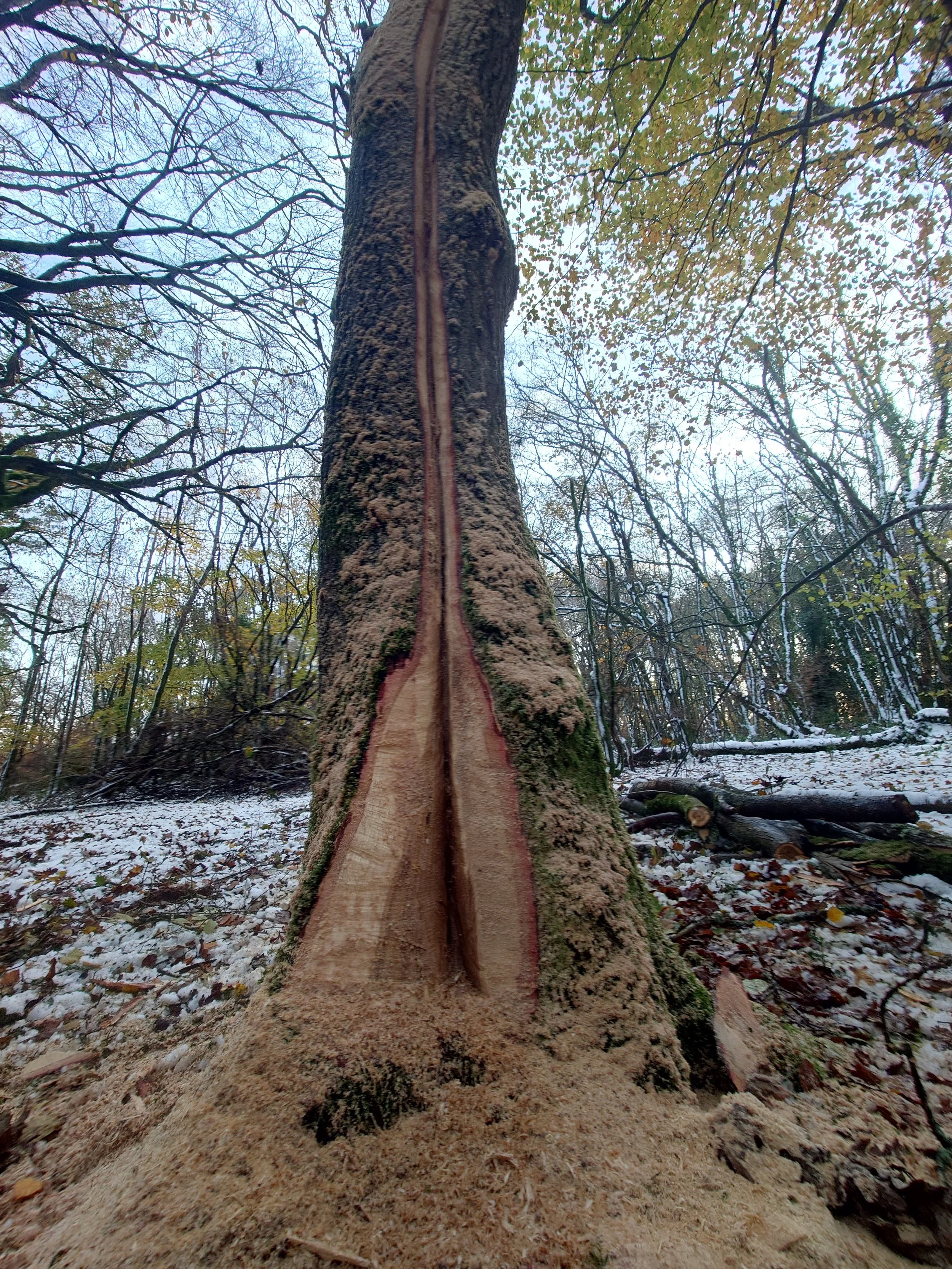LETTING THE FOREST BREATHE: WHY LIVING WOODS DEPEND ON DEAD TREES
Written by: Alejandra Hart
Veteran tree. Credit: Bull and Wolf
Restoring a forest is often seen as planting young trees or protecting ancient ones. Yet, the value of a rotting log, a hollow trunk, or a fallen branch is immense. Dead wood is among the most important habitats in a healthy woodland, particularly in a healthy temperate rainforest.
Dead wood is sometimes seen as untidy or a sign that a woodland is in decline. In reality, it is an essential part of the forest ecosystem. It supports fungi, invertebrates, birds, mammals, mosses, and lichens. It stores nutrients and slowly releases them back into the soil. It helps shape rivers and streams. It links the life of a tree to the next generation.
Southern bracket fungus on dead lime trunk. Credit: Colin Varndell
The process begins while a tree is still alive. A branch might die and remain attached to the trunk. A storm may split a limb, or lightning might scar the wood. Fungi enter through these wounds and begin to break down the chemical structure of the wood. Over time, this can create hollows and cavities. These spaces are used by nesting birds, roosting bats, and countless invertebrates. Studies in Europe have shown that almost a third of forest birds depend on tree cavities, yet in much of the UK these natural hollows are scarce.
Eventually, the tree may become a veteran. This is a tree with features that provide habitats for many other species, such as hollow trunks and large dead branches. Veteran trees can stand for decades, supporting wildlife above ground while fungi and invertebrates continue their work inside. When they finally fall, they continue to host life on the forest floor. In the damp conditions of Britain’s temperate rainforests, decay is quick and the variety of species that depend on it is very high.
Ancient Woodland restoration project at Avon Valley Woods. Credit: Sam Manning
Dead wood is also important in rivers. A fallen tree in a stream can slow the flow of water, reduce erosion, and improve water quality. The submerged wood becomes a home for invertebrates, a shelter for young fish, and a perch for birds such as kingfishers. Research has shown deadwood in rivers does not affect fish populations as they have evolved with trees falling in rivers for hundreds of thousands of trees. In headwater streams, fallen branches and trunks combine with moss, leaves, fungi and lichen habitats that support rare insects. Downstream, trees that settle in the shallows can sometimes take root again, helping to form wooded islands.
Despite this importance, most UK woodlands do not contain enough deadwood. The Forestry Commission guidance suggests around 20 cubic metres per hectare, which would be similar to a lorry load, or five to ten mature trees. Large pieces of deadwood, both standing and lying on the ground, have the greatest value for wildlife, yet these are often the first to be removed. Where there are very few veteran trees, new techniques are being tried to create habitats more quickly.
One method, known as veteranisation, involves carefully damaging younger trees in ways that mimic natural processes without harming the overall health of the tree. Techniques can involve removing or pruning branches to simulate storm damage, creating small cavities or holes similar to those made by woodpeckers, or scarring trunks in ways that resemble historical damage caused by large herbivores. These treatments can speed up the development of hollows and decaying wood without killing the tree. They are not a replacement for ancient trees but can help to fill the gap between the old trees we have now and those of the future.
Lightning strike effect on an oak tree. Small incision has been made from the top of the trunk to the base. Water will trickle down here, and fungi will slowly start to decompose the tree. Credit: Danielle Semple
Ring barking - by cutting off the trees water and sugar system it will slowly die standing - this is a really rare type of habitat (standing deadwood). Credit: Danielle Semple
To restore our temperate rainforests, we need to see dead wood as part of the living system. It is not waste material to be cleared away but a vital stage in the forest’s natural cycle. By keeping more deadwood in our woods and rivers, we can support a wider range of species, strengthen the links between land and water, and ensure these unique rainforests continue to thrive.
Get involved today and support us in the restoration of the South West’s temperate rainforests.
Bird Bath- the stump of a small tree that was felled (as part of our halo thinning work to prioritise some older trees to become veterans of the future) and a small hollow was made to act as a natural bird bath and source of water. Credit: Danielle Semple
Rainforest Recovery is the South West strand of The Rainforest Restoration Project. It is being led by the Woodland Trust in partnership with Plantlife. This project is funded as part of the Government's Species Survival Fund. The fund was developed by Defra and its Arm's-Length Bodies. It is being delivered on behalf of Defra by The National Lottery Heritage Fund.







